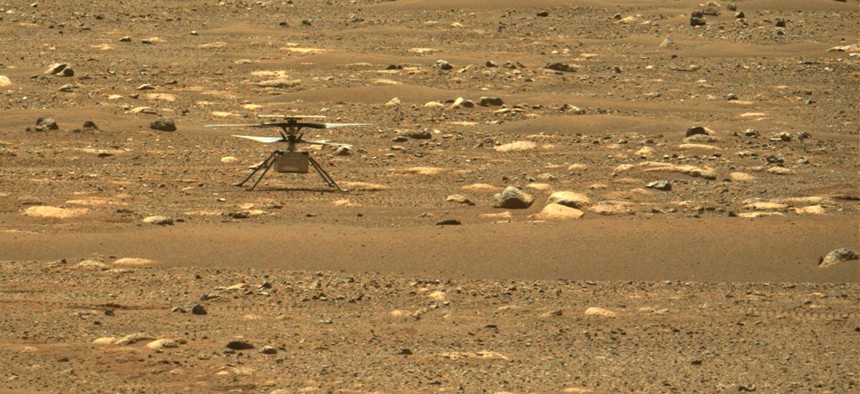The New Space Race Will Be Run by Robots

This image from NASA’s Perseverance rover shows the agency’s Ingenuity Mars Helicopter right after it successfully completed a high-speed spin-up test. NASA/JPL-Caltech/ASU
Given the risks of space travel versus the potential rewards, it seems like robots are better suited for this role than humans.
As robots have advanced in both artificial intelligence and capabilities, people have started to fear that their jobs could be replaced by them. I have written about this several times in my Nextgov columns. And many other reporters and writers have covered this same topic. While it’s clear that the government is trying to embrace increasingly intelligent robotic process automation that could promote robots to higher-functioning jobs and positions, the general consensus is that humans will have lots of job opportunities for years to come.
That is unless your job of choice happens to be an astronaut. Not to disappoint kids or steer them away from one of the most popularly picked potential careers, but the future in this area belongs to robots. Yes, NASA is still foraging ahead with the Artemis Project, which aims to put people on the moon by 2024 as a stepping stone to Mars. But given the risks of space travel versus the potential rewards, it seems like robots are better suited for this role.
Robots Are Doing a Great Job
The new NASA Perseverance rover is just getting started in its mission to find evidence of life on Mars, but it follows in a long tradition of robotic explorers that went well beyond their expectations. The first mission to Mars with a rover was with Pathfinder back in 1997. It was expected to last on the planet for about a week but kept performing for almost three months. During that time, it took 16,500 pictures and made 8.5 million measurements about the Martian atmosphere and soil.
Other standouts include the Spirit and Opportunity rovers in 2013, with both robots expected to last for about 90 days. Spirit kept working through several mission extensions and kept providing information even after getting hopelessly stuck in soft soil. It finally went dark after six years. Opportunity lasted for seven years, roaming for miles across the surface of the red planet.
One of the reasons that Perseverance got a slow start is because of the revolutionary Ingenuity helicopter that it launched soon after landing. Ingenuity was meant as a technology demonstration to prove that aircraft could fly in the extremely thin Martian atmosphere. It did that within weeks of landing, becoming the first aircraft to fly on Mars. But like the robots that came before it, Ingenuity exceeded expectations. It has now accomplished several flights, complete with full video accompanying each one. Its most recent flight was even rendered by NASA in 3D.
With most of the proof of concept tasks out of the way, NASA plans to re-task Ingenuity as an aerial scout for Perseverance, looking ahead for any interesting spots to explore or potential hazards in the rover’s projected path. If all goes well, this duo could prove to be the most successful robotic Mars mission to date.
Other Nations Join the New Robotic Space Race
China seems to be closely following the U.S. in this area, with their very first robotic explorer, the rover Zhurong, landing on Mars this week. Launched from the Tianwen-1 spacecraft, which had been orbiting Mars since February, Zhurong landed in a very similar way as NASA’s Perseverance rover and will now take on a similar mission, looking for signs that life once existed on Mars, or may even still be there.
Other nations are also contributing. The United Arab Emirates Hope Orbiter is currently mapping a complete picture of the weather patterns on Mars from orbit. And India successfully got its own satellite into orbit as part of its Mars Orbiter Mission project in 2020.
Yes, it does seem like we have the makings of a new version of the original Space Race that dominated space exploration and mission planning in the 1950s and for over 30 years afterward. But unlike the bitter contest held between the United States and the Soviet Union, this space race seems a lot friendlier, with some of the participants eager to share their data and findings with one another.
And lest we forget that space exploration is a dangerous endeavor and largely a new science, the same week that China was celebrating landing Zhurong on Mars, we also learned about a rocket failure that resulted in the total destruction of two satellites. That disaster barely made the news because nobody got hurt. Some important equipment was lost, but it’s just stuff. As long as robots are doing a great job performing scientific missions, then there is little to gain by risking people’s lives to perform the same tasks, probably with much less efficiency than a tireless robot.
Whenever we discover a critical job that can’t be done by a robot, then we can shift to human-centered missions once more. Maybe we will find evidence of life on Mars or even an ancient civilization. And when that happens, we might need to send humans to investigate. But until that day comes, we should just let robots focus on what they do best and keep humanity safe at home.
John Breeden II is an award-winning journalist and reviewer with over 20 years of experience covering technology. He is the CEO of the Tech Writers Bureau, a group that creates technological thought leadership content for organizations of all sizes. Twitter: @LabGuys
NEXT STORY: Why Do We Hate the Sound of Our Own Voices?






